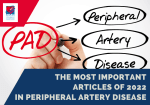This study compared fractional flow reserve (FFR) vs. angiography to guide the angioplasty of non-culprit vessels in patients with acute coronary syndrome (ACS) and multivessel disease. Landmark studies such as COMPLETE, COMPARE-ACUTE and DANAMI-3-PRIMULTI have demonstrated the prognostic value of revascularization (after treatment of the artery responsible for the ACS) of non-culprit arteries with respect<a href="https://solaci.org/en/2023/01/25/frame-ami-ffr-vs-angiography-of-non-culprit-vessel-in-acs/" title="Read more" >...</a>
Long-Term Evolution of Hybrid Coronary Revascularization
Currently, myocardial revascularization surgery (MRS) and percutaneous coronary intervention (PCI) are the available strategies for multivessel coronary artery disease. However, an alternative strategy has long been developed, called hybrid coronary revascularization (HCR), where the anterior descending artery is bypassed with a graft from the mammary artery and the rest of the lesions are treated by<a href="https://solaci.org/en/2023/01/23/long-term-evolution-of-hybrid-coronary-revascularization/" title="Read more" >...</a>
The Most Important Articles of 2022 in Peripheral Vascular Disease
Discover the most important scientific articles of 2022 in peripheral vascular disease in our website. EMINENT Trial | Stent Eluvia vs BMS in Femoropopliteal Territory Endovascular therapy in femoropopliteal territory has become the standard, mainly with self-expanding stents, aimed at preventing early vascular recoil and late constrictive remodeling. Thromboendarterectomy vs. Endovascular Therapy in Common Femoropopliteal<a href="https://solaci.org/en/2023/01/19/the-most-important-articles-of-2022-in-peripheral-vascular-disease/" title="Read more" >...</a>
Intervention in Patients with Takayasu Arteritis: Rescue Therapy or an Alternative Complementary to Immunosuppressive Therapy?
Takayasu arteritis (TAK) is an uncommon granulomatous large-vessel vasculitis that affects the aorta and its primary branches. The most frequently types of observed vascular compromise are obstructive lesions, and aneurysmal vascular lesions or dissections. In 2021, the American College of Rheumatology recommended not to implement percutaneous intervention (PI) with these patients and only use immunosuppressive<a href="https://solaci.org/en/2023/01/18/intervention-in-patients-with-takayasu-arteritis-rescue-therapy-or-an-alternative-complementary-to-immunosuppressive-therapy/" title="Read more" >...</a>
Can We Use DAPT for 3 Months in Acute Coronary Syndrome?
Current guidelines recommend 12-month dual antiplatelet therapy (DAPT) after DES stenting for acute coronary syndrome (ACS) because of elevated MACE risk. The development of more modern stents, with thin and ultrathin struts, compared against prior versions, has resulted in more effective devices in terms of stent thrombosis and restenosis. Prolonged DAPT has been associated with<a href="https://solaci.org/en/2023/01/12/can-we-use-dapt-for-3-months-in-acute-coronary-syndrome/" title="Read more" >...</a>
Ticagrelor or Prasugrel Post-PCI in Daily Practice Patients
The ISAR-REACT 5 showed a significant reduction in the composite outcome of death, acute myocardial infarction (AMI), or stroke when using prasugrel vs. ticagrelor in patients with acute coronary syndrome (ACS), mainly at the expense of an AMI reduction. While this study changed clinical practice, it has stirred some criticism regarding certain methodological aspects, such<a href="https://solaci.org/en/2022/12/19/ticagrelor-or-prasugrel-post-pci-in-daily-practice-patients/" title="Read more" >...</a>
Do Symptoms and Quality of Life Differ between Focal and Diffuse Coronary Artery Disease?
Changes in fractional flow reserve (FFR) values after percutaneous coronary intervention (PCI) are associated with improvement in angina symptoms. The pattern of baseline coronary artery disease influences the degree of variation in FFR after stent implantation. Focal coronary artery disease leads to high post-PCI FFR values, while the improvement is not as marked in diffuse<a href="https://solaci.org/en/2022/12/14/do-symptoms-and-quality-of-life-differ-between-focal-and-diffuse-coronary-artery-disease/" title="Read more" >...</a>
How Do We Manage Antiaggregation in BARC I Bleeding after AMI?
Dual antiplatelet therapy (DAPT) after acute myocardial infarction (AMI) has been shown useful to reduce thrombotic events, but one of its downsides is bleeding, especially in elderly patients. BARC bleeding type I, also called nuisance bleeding (NB), is of low frequency, but its evolution and impact remain unclear, as does its management. A subanalysis of<a href="https://solaci.org/en/2022/12/07/how-do-we-manage-antiaggregation-in-barc-i-bleeding-after-ami/" title="Read more" >...</a>
P2Y12 Inhibitor Monotherapy vs Aspirin: Results of a Network Meta-Analysis
Revascularization and antiaggregation guidelines have typically recommended aspirin (AAS) as first choice for secondary prevention of cardiovascular events after DES stenting. However, these past few years this strategy has been called into question, seeing as studies have shown the superiority of P2Y12 inhibitor monotherapy (IP2Y12) with clopidogrel or ticagrelor. There is little data comparing both<a href="https://solaci.org/en/2022/12/05/p2y12-inhibitor-monotherapy-vs-aspirin-results-of-a-network-meta-analysis/" title="Read more" >...</a>
Post PCI FFR
Much research has been done on the usefulness of functional testing such as fractional Flow reserve (FFR) after percutaneous coronary intervention (PCI), resulting in the correlation of pathological FFR values with major adverse events at 6 months, as shown by Pijls, et al. The impact of post PCI FFR on prognosis has not been studied<a href="https://solaci.org/en/2022/11/30/post-pci-ffr/" title="Read more" >...</a>








